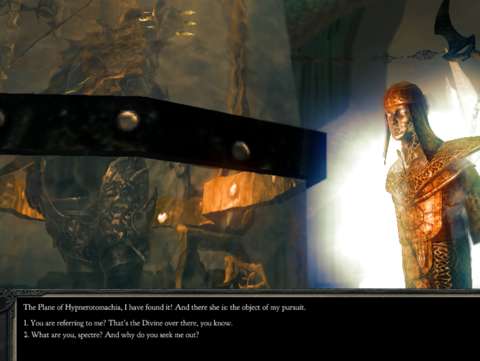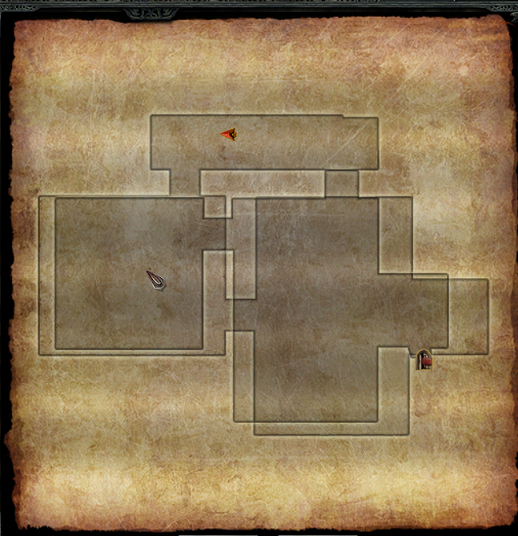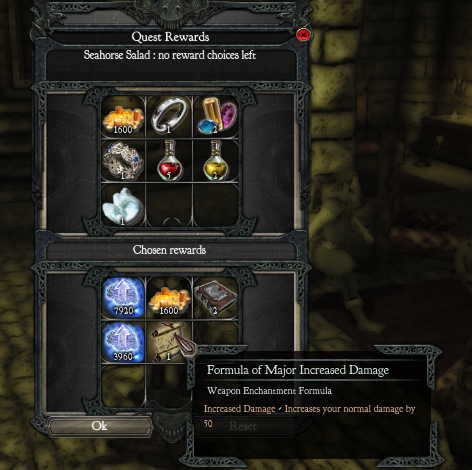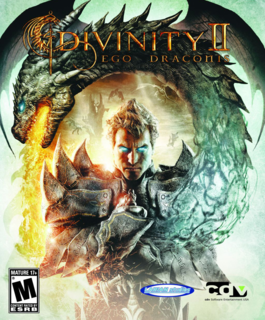INTRO:
Larian Studios is not new to writing less-than-happy endings for its games. Divine Divinity ended with a big mistake on the part of the protagonist. The betrayal at the end of Beyond Divinity is practically a forgone conclusion that could have been spotted right from the beginning.
However, Ego Draconis ended with an abrupt cliffhanger and not entirely well-explained plot twist. Of course, such plot tools are nothing new and the fantastical setting does allow for such unforeseen turns of events. On the other hand, this would have been easy to call out as lazy writing and a dissatisfying end after many hours of gameplay and narrative.
Flames of Vengeance is intended to remedy that, albeit that it came with a price tag since it is marketed as an “expansion pack”. (Both titles would later be consolidated into the Director’s Cut.)

PREMISE:
The aforementioned cliffhanger is that the protagonist has somehow been suckered into trapping himself/herself in the afterlife after having unwittingly revived a primary villain. The excuse for this abrupt plot twist is how little the protagonist knows about how the “Hall of Echoes” (the name for the aforementioned afterlife) works, in contrast to how much the primary villain knows about it.
The cliffhanger was that the protagonist has been trapped in the afterlife after having unwittingly resurrected the lover of Damian, who is the Damned One. The voice-in-the-head character turns out to be said person, who have tricked the protagonist through a typical “but-thou-must” plot-line in Ego Draconis. The protagonist also discovers that Lucian the Divine is alive but trapped too.
This expansion would introduce another character, apparently yet one more of the “ancient evil being” archetype. This one is also of the “evil wizard” sort, who so happens to know how to project his spirit into the Hall of Echoes. This evil wizard finds and ‘recruits’ the protagonist through yet another “but-thou-most” plot-line. The reason behind this choice is of course obvious: the protagonist is a proven dupe. This evil wizard will then become the next voice-in-the-head.
The protagonist is then tossed into Aleroth, a major city of Rivellon. Thanks to the events of the previous game, and the bungling of two good-aligned wizards, it has recently been afflicted with undead. Things turn for the worse; Damian and his warhost have arrived, and their arrival has awoken various sleeper cells in Aleroth.
Zandalor, the most bungling of wizards, decides that he should be used as the anchor for an ancient and powerful shielding spell. The spell can hold back Damian’s warhost, but Zandalor cannot sustain it forever. Thus, again, he has instructed (through an intermediary) the protagonist to look for the aforementioned evil wizard and get a magical weapon of mass destruction from him through whatever means – so far, so familiar.
NO NEW GAMEPLAY ELEMENTS:
Ego Draconis gradually introduced gameplay elements one after another. Flames of Vengeance will not, because it does not have any new ones to offer.
This might not be an issue to players that played the Director’s Cut version of Ego Draconis; the playthrough simply transitions to Flames of Vengeance content after the ending of Ego Draconis. People who have bought the license for the original version of Flames of Vengeance and played it might not be pleased though.

NO IMPORTING CHARACTERS FOR DIRECTOR’S CUT VERSION:
If the player begins a playthrough using the expansion’s content in the Director’s Cut version of Divinity II, there are no means of importing player characters from playthroughs of the original version of Ego Draconis. If the player begins playing with the expansion anyway, the player has to make a new character with resources and capabilities that a level 35 or higher character would presumably have, at least in the eyes of the developers.
QUEST ITEMS CLEARED:
If there is any silver lining to the transition to the expansion, it is that all quest items except the Dragon Stone and the Crystal Skull have been removed. Previously, they would have taken up inventory squares and counted towards the item limit for the inventory. Thus, this is a welcome change.
Of course, there would be more unused quest items to be found so that they can take up space. Larian Studios has yet to tighten its coding for quests and quest items.
BATTLE TOWER RETAINED:
If the player has transitioned from Ego Draconis, the player retains the use of the Battle Tower, with the catch that any quests that are related to upgrades are outright gone. If the player has not upgraded the amenities there via the quests, they retain their levels and can never be improved.
There are some changes though. Sassan, the only merchant in the tower, has her gold reserves restored. Unfortunately, the waypoint shrine in the tower has been broken. This means that the player character can only return to where he/she was before he/she went to the Tower.
WAYPOINT SHRINE LIST RESET:
Thanks to the convenient plot point of Damian’s forces having overrun many of the places in Ego Draconis, the list of waypoint shrines have been reset. Fortunately, Aleroth has a considerable number of these shrines, thanks to having been the home of wizards.
ADDITIONAL SPECIALISTS:
Fortunately, players who have not done the quests to upgrade the tower’s amenities would be able to find NPCs that provide similar services. Most of them do so at the same level as the most-upgraded amenities too. The only catch is that they are not within the same area, so they are not as convenient to peruse.
HIGHER-LEVEL TRAINERS:
These NPCs include two skill trainers. One of them offers skill cap increases that cannot be obtained from the trainer at the Battle Tower.
Lockpicking in Ego Draconis was capped at level 5. Flames of Vengeance introduces two more levels. The cap cannot be raised through the trainer at the Battle Tower, but there is the trainer in one of the government buildings that can raise the level cap. There is also one NPC that can be mind-read to yield an increase in the skill.
That same trainer in the government building can also raise the skill cap for the Destruction skill, thus increasing the damage that the player character can dole out with spells.

MOSTLY ON-FOOT GAMEPLAY CONTENT:
The playthrough begins with the player going through content in the city of Aleroth. This is reminiscent of the first act of Ego Draconis, which is the Broken Valley Village and its surprising number of quests. In the case of Aleroth, being a city meant that it has an even higher density of quests and characters. Indeed, the player would be coming across many NPCs, all of which can be talked to and most of which are involved in this or that quest.
The player character would be doing quests about suspicious going-ons in the city. Most of them would have themes and plot points that are related to the siege of Aleroth, and the lack of manpower that its defenders suffer from. Obviously, such a set-up meant that there would be quests about the player character helping people in need, and/or occasionally stabbing them in the back for personal gain. (Speaking of personal gain, the player might want to have the wiki available, because the rewards from decisions in quests are not always consistently predictable.)
Conveniently, Aleroth is a very old city with many secrets, not least of which is the sealing-away of the earlier-mentioned evil wizard. Therefore, the player character would be delving into ruins and dungeons to look for this or that magical doo-dad or mysterious characters to contact.
VOICE-IN-THE-HEAD:
The protagonist is still vexed with a voice in one’s head. In the case of this expansion, this would be the evil wizard. Like Talana/Ygerna, the evil wizard would make remarks about this or that occurrence, but with a cynical slant that is dourer but with some dry wit.
However, he also happens to intrude on mindreading attempts. In these cases, the evil wizard’s remarks are uttered instead of the NPCs’ thoughts. Usually, the evil wizard’s remarks would inform the player about what the NPCs are thinking, but some of his remarks are vague, thus giving the impression that the mind-reading has been a waste of time.
SKYROCKETING MINDREADING COSTS:
Speaking of mindreading, the XP costs of mindreading NPCs have sharply risen. The costs are now at least 5 digits, which is incredible. These costs are incurred when reading the minds of civilians and characters that are not even supposed to have strong willpower.
In hindsight, this was likely implemented to address the possibility that the player character might have a high rating in Mindreading. In fact, at level 15, Mindreading has no XP cost at all. Having reached this level of Mindreading, the massive XP costs become a moot point.
HIGHER-LEVEL GEAR:
Expansion content for Western RPG typically includes gear pieces with higher numbers in their properties. Flames of Vengeance is not any different.
Close to the starting spot of the player character, there are some merchants that happen to include high-level gear in their stocks. There are even uniquely named weapons among these, which have numbers that are likely to be far beyond what the player character currently has. They also happen to have high level requirements, so the player character would not be able to use them until later.
They happen to have incredibly high price tags too. Players that have transitioned to Flames of Vengeance from Ego Draconic content might be better positioned to acquire them, if they have been saving up in anticipation of getting access to high level gear.
Other than these observations, the high level gear is typically boring. They are not functionally different from what have been in Ego Draconis.

YET MORE REFERENCES:
Ego Draconis has a lot of references to other works of fiction, as well as popular culture. For better or worse, there are more in Flames of Vengeance. Indeed, for example, the playthrough of Flames of Vengeance begins with a reference to the Terminator IP; it even has the infamous sound clip.
SPONGY ENEMIES:
Typically, expansion packs for Western RPGs that continue from where the original content left off would attempt to up the ante by increasing the challenge that enemies pose. In addition to the (lazily-implemented) increments of numbers for their statistics, they may have additional abilities. Flames of Vengeance go for both.
For better or worse, one of the additional abilities is a high-level Heal. Quite a number of enemies can heal themselves in the middle of battle. The player can attempt to interrupt this with certain attacks, like the combat skill that can knock down enemies, but there are not a lot of these. What there are happen to have animation lengths and other caveats that make it very difficult to interrupt them on time. Furthermore, the enemies will just try healing again afterwards, if they survive.
MELEE BUILDS NOT EFFICIENT WITHOUT FATALITY SKILL:
Unfortunately, due to pervasiveness of healing spells that enemies have, melee builds have become untenable. This is due to the behaviour of enemies that have healing spells.
Usually, these enemies are magic-users, preferring to attack from afar. If the player character gets close, they may run away – during which they regenerate mana, building it up for a healing spell. Other magic-users would whip out their warhammers to engage the player character in melee; of course, regular melee attacks do not cost mana, so they can accumulate mana for a healing spell.
The player could still try to whittle them down anyway, but this is a slog. The player is better off investing points into the Fatality skill, which lets the player finish off weakened opponents.
Indubitably, ranged/magic builds are more efficient in the long run against such enemies, if only because the magic-users would use their mana to cast spells at the player character, thus preventing them from accumulating enough mana for healing.
DRAGON-FLIGHT SEGMENT IN SEMI-FINALE:
Since most of the game takes place in a densely-constructed city, there are no means to change to a dragon-form. Indeed, some people still refer to the player character as the “Dragon Slayer”, apparently because they have not seen his/her dragon-form yet. There is also the matter of Zandalor’s shield, which removes any notion of the dragon-form being useful as long as it is up.
Thus, the dragon-flight segment is only reserved at the end – for an escort mission.

ESCORT MISSION:
This is a spoiler of course, but it also concerns gameplay – or rather a perennial problem in video game designs. This is the task of escorting an NPC.
There had rarely been any escort mission in video game history where it is a positive experience. One could argue that keeping the escortee safe is very much the point, but having more control of the escortee would have made this job so much more reliably achievable.
This is not the case with Flames of Vengeance. The escortee is of the kind that will keep moving on its own volition, thus exposing itself to enemy attacks. The escortee is very heavily armed, but its health is on a one-way trip to zero.
Therefore, the player has little choice but to have the dragon surge ahead to draw fire and systematically knock out the worst of threats. This would have been doable for any players that have plenty of (unpleasant) experiences with escort missions, but this also reveals a problem that might irk people who are familiar with the dragon-form in Ego Draconis.
DIFFERENT DRAGON BUILD:
Apparently, the code build of the dragon-form in Flames of Vengeance is not the same as the one in Ego Draconis. The player is given one that is unique to the escort scenario. This also means that whatever effort that the player has invested into the dragon-form of Ego Draconis has been disregarded.
The most notable difference is that the dragon-form’s default fire-breath form has been reset to its default level – which is weak. It also drains much more mana, for whatever reason. This makes the default fire-breath impractical for this mission, perhaps to the chagrin of players that have made builds that have the dragon-form circle-strafe targets while roasting them.
Thus, the player has to resort to using the dragon form’s ranged combat skills – one of which happens to be an area-effect fireball, something that had been omitted from the dragon-form in Ego Draconis. Fortunately, this is powerful enough to knock out entire clusters of towers, which helps a lot in clearing the path for the escortee.
SOUND PROBLEM IN ESCORT MISSION:
Unfortunately, if the player makes save-games during that mission and reloads them when it goes awry for whatever reason (likely after realizing that the default dragon-breath is useless), the audio of the game breaks. It will return to normal until after the scenario has been completed. There is nothing important to be heard during the scenario, but not hearing anything certainly saps a lot of the appeal of this scenario. The player would have to reload a game-save prior to the start of the mission and replay it again.
AESTHETIC DESIGNS:
Being an expansion pack, Flames of Vengeance runs on the same Gamebryo build that Larian Studios has used for Ego Draconis.
The main difference in the aesthetic designs of the expansion content is that the game takes place in a city – such a locale was not shown in Ego Draconis. This means that the player will be seeing plenty of cobblestones, wooden support beams and clay tiles, both indoors and outdoors. There are also castle walls and large district gates.
Fortunately, there is some variation in the environments that the player would see, thanks to the ancient origins of Aleroth. There are ancient tunnels, ruins that have been built over and such other old and forgotten places. On the other hand, most of these other environments have been made using assets that had already been in Ego Draconis. Many of them are going to look all too familiar.
Still, there are some impressive moments. For example, there is the aforementioned escort scenario. The player can see the flying fortresses that the Black Ring is fielding, set against the light of the sun and above the clouds.

SUMMARY:
Flames of Vengeance is, ultimately, one of those expansion titles that offer nothing new in terms of gameplay. It does resolve an odious cliffhanger with another one that is more palatable, but it would have been worth its asking price when it was marketed as an expansion back in the early 2010s. The consolidated Director’s Cut version of the game should have addressed this, but the omission of certain features like imports of game-saves would give the impression that Larian Studios just did not have the capability to deliver an ideal outcome.

